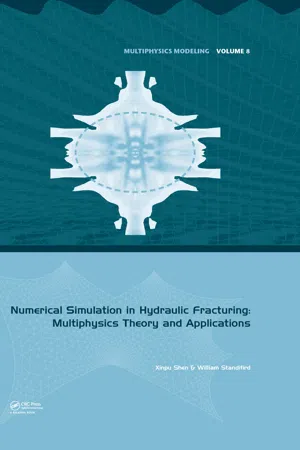
Numerical Simulation in Hydraulic Fracturing: Multiphysics Theory and Applications
Xinpu Shen,William Standifird
- 168 Seiten
- English
- ePUB (handyfreundlich)
- Über iOS und Android verfügbar
Numerical Simulation in Hydraulic Fracturing: Multiphysics Theory and Applications
Xinpu Shen,William Standifird
Über dieses Buch
The expansion of unconventional petroleum resources in the recent decade and the rapid development of computational technology have provided the opportunity to develop and apply 3D numerical modeling technology to simulate the hydraulic fracturing of shale and tight sand formations. This book presents 3D numerical modeling technologies for hydraulic fracturing developed in recent years, and introduces solutions to various 3D geomechanical problems related to hydraulic fracturing. In the solution processes of the case studies included in the book, fully coupled multi-physics modeling has been adopted, along with innovative computational techniques, such as submodeling.
In practice, hydraulic fracturing is an essential project component in shale gas/oil development and tight sand oil, and provides an essential measure in the process of drilling cuttings reinjection (CRI). It is also an essential measure for widened mud weight window (MWW) when drilling through naturally fractured formations; the process of hydraulic plugging is a typical application of hydraulic fracturing. 3D modeling and numerical analysis of hydraulic fracturing is essential for the successful development of tight oil/gas formations: it provides accurate solutions for optimized stage intervals in a multistage fracking job. It also provides optimized well-spacing for the design of zipper-frac wells.
Numerical estimation of casing integrity under stimulation injection in the hydraulic fracturing process is one of major concerns in the successful development of unconventional resources. This topic is also investigated numerically in this book. Numerical solutions to several other typical geomechanics problems related to hydraulic fracturing, such as fluid migration caused by fault reactivation and seismic activities, are also presented.
This book can be used as a reference textbook to petroleum, geotechnical and geothermal engineers, to senior undergraduate, graduate and postgraduate students, and to geologists, hydrogeologists, geophysicists and applied mathematicians working in this field. This book is also a synthetic compendium of both the fundamentals and some of the most advanced aspects of hydraulic fracturing technology.
Häufig gestellte Fragen
Information
CHAPTER 1
Introduction to continuum damage mechanics for rock-like materials
1.1 INTRODUCTION
Inhaltsverzeichnis
- Cover Page
- Half Title
- Title Page
- Copyright Page
- About the book series
- Editorial board
- Table of Contents
- Foreword by M.Y. Soliman
- Authors’ preface
- About the authors
- Acknowledgements
- 1 Introduction to continuum damage mechanics for rock-like materials
- 2 Optimizing multistage hydraulic-fracturing design based on 3D continuum damage mechanics analysis
- 3 Numerical analysis of the interaction between two zipper fracture wells using the continuum damage method
- 4 Integrated workflow for feasibility study of cuttings reinjection based on 3D geomechanical analysis and case study
- 5 Geomechanics-based wellbore trajectory optimization for tight formation with natural fractures
- 6 Numerical solution of widened mud weight window for drilling through naturally fractured reservoirs
- 7 Numerical estimation of upper bound of injection pressure window with casing integrity under hydraulic fracturing
- 8 Damage model for reservoir with multisets of natural fractures and its application in the simulation of hydraulic fracturing
- 9 Construction of complex initial stress field and stress re-orientation caused by depletion
- 10 Information transfer software from finite difference grid to finite element mesh
- Nomenclature
- References
- Subject index
- Book series page